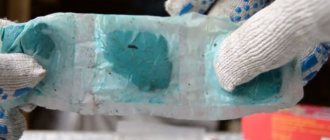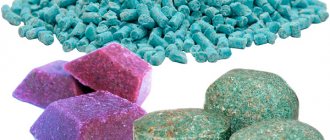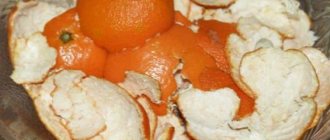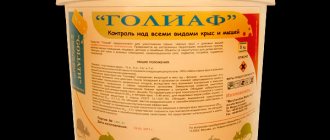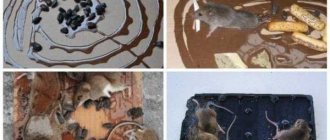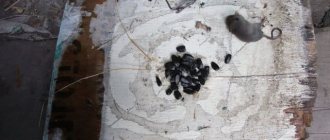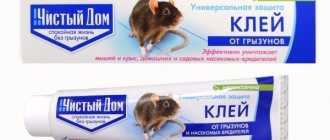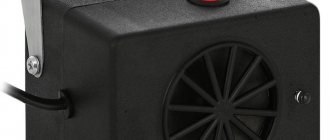Next you will learn:
- Is glue from rats and mice really effective in practice and what should you know in advance about the disadvantages of this product?
- What brands of glue for rodent control are on the market today and do manufacturers add poison to the adhesive composition;
- How to use glue traps correctly and what important nuances need to be taken into account to increase their effectiveness;
- What to do if glue ends up on clothes, hair or the fur of a pet - how can you wash it off without tormenting yourself and your pet with the terrible smell of the solvent;
- What else can be used against rats and mice instead of glue, if you still can’t control rodents with this product...
Special glue for rats and mice is quite effective, but not entirely humane, since an animal stuck to a trap is doomed to a long and painful death. If we talk about reliability, then the glue is quite comparable to well-proven mousetraps and rat traps, but at the same time it has specific rules of use, due to which its use in residential premises may be associated with certain difficulties.
It is believed that glue for rats and mice began to gain the greatest popularity after glue traps for cockroaches entered the market. Residents of apartments and private houses have found that such sticky insect traps are very easy to use, highly effective and completely safe for people and pets.
It is not surprising that ordinary people first tried to use glue against rats and mice on their own, making homemade glue traps, and then this trend was quickly taken up by enterprising manufacturers, and specialized glue for catching rats and other rodents appeared on sale. But the fact is that mice and rats are not cockroaches, and using glue against them has some features, which we will talk about later.
How glue traps work and how effective they are
The principle by which glue for catching rats and mice works is quite simple: having stepped once on a surface coated with glue, the animal cannot tear its paw away from it, it rests against it with its second paw, it also sticks, and the rodent is caught.
Often, rats and mice stick to the glue not only with their paws, but also with their fur, and they are completely immobilized. After being caught, the animal tries to break away from the glue for several days until, exhausted, it dies of thirst. It should be borne in mind that if the person who set the trap finds the animal still alive, he has to kill the rodent in some other way, or simply throw the trap with the still living prey into the trash can.
Glue for catching rats and mice turns out to be quite effective due to the fact that rodents easily fall into it by simply running over the trap. That is, if you choose the right installation location, such a sticky rat trap helps to catch even those particularly careful pests that do not fall into traditional traps with bait, such as mousetraps.
On a note
You can significantly increase the effectiveness of rodent control by using a glue trap with bait, for example, a piece of bread. Bread is placed in the center of the trap, and the area near it is treated with glue on all sides. Thus, the rodent has no choice but to stick to the tasty morsel. But it is worth noting that rats and mice are caught just as easily without bait if sticky traps are simply installed in places where these pests are most likely to move.
How to dispose of caught rodents
Many people wonder how to dispose of caught rodents? A common solution is to simply throw it away. There is no need to wait for the creature to die, since the odor emitted from the corpse will not only be extremely unpleasant, but also difficult to remove. But remember that a newly attached animal can be aggressive.
Before disposal, it is advisable to place the animal in several plastic bags until completely sealed. Firstly, the rodent will die faster from lack of oxygen. Secondly, there will be a guarantee that no one will eat it. The latter is really important, because these animals are carriers of many diseases.
A few words about the disadvantages of using glue against rodents
Like any other product, rat glue is not without its drawbacks. Let's take a closer look at them:
- Perhaps one of the main disadvantages of glue for mice and rats is that the use of such a product can hardly be called humane. In the video presented at the end of this article, you can see what such a sticky rat trap looks like with a caught animal: the rodent in the trap will suffer a slow and painful death from thirst over several days. If you find him still alive, then you will have to suffer, thinking about how to get rid of him. Not everyone would raise their hand to kill a defenseless little mouse, however, throwing it still alive into the garbage chute would be no less cruel;
- There is a danger of glue from glue traps getting on children's skin and pet fur. In rare cases, glue may cause irritation or an allergic reaction if there is an individual sensitivity to its components. It is very difficult to remove glue from hair or wool, and in many cases you just have to cut off the stuck area and use chemicals, such as solvent, to remove the adhesive from the skin;
- Rats and mice, once trapped, emit a loud squeak or even squeal for a long time, which can cause significant discomfort to people;
- If dust or moisture gets on the surface of the glue, it may somewhat reduce its effectiveness, so you need to keep the trap clean and replace it if necessary.
Review
“We bought Alt glue against mice and rats; a neighbor recommended it to us. I still have very mixed feelings, now I’m writing a review, but I’m still pounding. Everything was according to the instructions, they were spread on a piece of cardboard and placed under the refrigerator, where I most often sweep out the trash. In the morning I come, take out this cardboard, and there lies this mouse, all twitching, squeaking, stuck to its side, squirming so terribly, apparently it was recently caught. I threw up right there. My husband came running, took the whole trap, took it out into the garbage chute, and calmed me down. Well I do not know. It seems like the remedy worked, but I won’t survive this again.”
Oksana, Kyiv
Anyone wishing to use it against rats or other pests will have to put up with the noted disadvantages of the glue. However, it is worth noting that rat glue copes quite well with its main function - catching rodents. And if you are not afraid of the prospect of periodically turning into a kind of executioner, deciding the fate of the animals you come across, then you can safely start choosing an adhesive.
It is also useful to read: Choosing an effective electronic rat and mouse repeller
Advantages and disadvantages
Like all disinfestation tools, mouse glue has both positive and negative sides.
The undoubted advantages of anti-rat glue are:
- ease of use;
- long period of validity;
- no odor;
- absence of toxic fumes;
- low cost.
The disadvantages of glue traps for rats include the following factors:
- if handled carelessly, anti-mouse glue can get on your hands and floor, and it is difficult to remove;
For more information on how to remove glue from mice, read our article: How to quickly remove glue from mice.
- you may find the victim still alive and squeaking loudly;
- A pet may get caught in the trap.
Large pets, such as dogs and cats, will have to have their fur and glue cut off, while small pets, such as guinea pigs and hamsters, may die.
Brands of adhesives for mice and rats
There are many brands of rodent glue on the market today. The most popular of them are the following:
- Alt rodent repellent glue is perhaps one of the most popular products in this category, made in Russia;
- RaTrap is a Czech-made product, suitable not only for fighting against rats, mice and other rodents, but also against insects;
- Kotofey is a Russian-made glue for catching mice and small rats;
- EuroGuard – Italian glue for mechanical catching of rodents and insects;
- Clean House - Russian glue for rats, mice and insects;
- Forssyth - adhesive mass against rodents, country of origin - Russia;
- Trap is a Russian-made glue against rats, mice and insects.
All products on the market have standard packaging - an aluminum tube containing 135 grams of glue inside (with the exception of Clean House glue, the tube of which contains 130 grams of the substance). Buying such rat glue will cost you between 150-250 rubles apiece. It is worth noting that all adhesives have the same principle of operation and are very close in effectiveness, so in order to truly appreciate this product, you can choose any of the brands presented.
Also on sale are ready-made glue traps for rats and mice of such brands as “Pregrada”, “Mr. Mouse" and "Clean House" - cardboard boxes with glue that simply open, fold as desired (in the form of a house, a tunnel or a simple platform) and are installed on the paths of movement of rodents. In this case, you don’t even need to apply the glue itself to anything, although in the end such traps turn out to be more expensive than a simple tube of glue.
On a note
There is an opinion that rat glue contains poison, but this is not true. Rodent control adhesives are mostly non-toxic and have no odor that could repel rats and mice or cause discomfort to humans. Some add special flavors that attract rodents, which eliminates the need for bait. The active ingredients of the adhesives are also approximately the same; only their dosages may differ. Basically, these are fairly inert and safe polymers - about 80% polybutylene, and the remainder in approximately equal proportions consists of polyisobutylene and cyclosane.
History of appearance
The first step towards the appearance of glue for rodents was the release by the chemical industry of a similar product for cockroaches. With its active use against insects, many residents, paying attention to the ease of use and low cost, began to make such traps for rodents on their own.
The entrepreneurs quickly got their bearings and launched the production of glue with a special composition intended for rats and mice. The main feature of this substance is that after applying the drug to any surface, it retains its sticky properties for a long time.
Rules for using glue when fighting rodents
Using glue against rats and mice is easy. Let's look at the process of preparing a glue trap:
- Take a piece of flat and smooth material, such as cardboard, plastic or wood, measuring at least 10x10 cm in case of fighting mice and 25x20 cm in case of catching rats. In the second case, it is also recommended to attach the base to the floor using self-tapping screws. Otherwise, the animal may carry the entire trap with it and smear the room with glue;
- In case of fighting mice, you need to spread glue on the substrate in strips 1-2 cm wide with a distance of up to 5 cm between them. If the trap is set to catch rats, then this will not be enough, and the stripes will need to be made wider and further apart - 3-5 cm and 10 cm, respectively. It should be noted that the product acquires irreversible stickiness 30 minutes after application;
- It is advisable to place bait in the center of the trap, for example, a piece of bread soaked in vegetable oil;
- It is necessary to place rat traps in those places where rodents are most likely to appear - in corners, along walls and partitions, near visible holes, at a distance of 3 to 15 meters from each other, depending on the size of the room, its clutter and the number of pests . At the same time, it is necessary to provide the substrates with shelter from children and pets and to minimize contamination of the adhesive surface, so it is better to lay them out under furniture, boards leaning against the walls, or in special bait houses;
- Periodic inspection of substrates with glue is required to collect and dispose of rats and mice, as well as to replace littered substrates with new ones.
If the trap is used to catch rats, it must be checked at least once a day. The fact is that a stuck animal will make sounds of danger (squeak), which is why its relatives will avoid this place. But when mice are caught using glue, this factor turns out to be insignificant - these rodents easily run into the trap of several animals in a short period of time.
You will have to decide for yourself what to do with the caught rodents. Perhaps the most humane way is to generously moisten a handkerchief in gasoline or acetone and cover the animal with it so that it first loses consciousness and then suffocates. But few people do such delights. Traps are usually simply thrown into the garbage chute with still living animals, dooming them to a long and painful death. Someone kills mice with a hammer, and someone even begins to mock them...
You might think that the glue on the trap dries out over time, but thanks to its special composition this does not happen and it remains effective until its surface becomes clogged with dust or dirt. In this regard, it is recommended to replace the adhesive substrates with new ones approximately once a week.
It is also useful to read: Ultrasonic rat and mouse repeller Tornado 400 and reviews of its use
Ready-made glue houses, containers and tapes
Glue traps In stores, there is a wide selection of not only mouse glue in tubes, but also ready-made designs for catching mice are sold:
- An adhesive mousetrap in the form of a plastic container containing an insecticidal-rodenticidal adhesive mass has dimensions of 55x130 mm, usually there are 2 pieces in a package.
- A cardboard mouse trap containing mouse adhesive includes scent additives to attract pests. Alt, Clean House, etc. are popular.
- Adhesive plates or books along with the applied substance are usually sold in several pieces per package. An example of funds is Mr Mouse, Kotofey, etc.
- Velcro for mice - made on the basis of a folding house with a sticky layer applied inside. The main advantage of this design: you do not need to coat the cardboard yourself; the adhesive and coated mice are inside, and as a result are inaccessible to children and pets.
- Mice sticky tape is a wide strip of adhesive applied to the center of which bait food is placed.
Safety precautions when handling glue
Despite the fact that rat catching glue does not contain toxic substances, certain safety rules must be followed when working with it. The fact is that glue, due to its stickiness, can cause problems if handled carelessly.
Actually, this is why it is so effective, but for the same reason it requires compliance with safety measures:
- It is recommended to use rubber gloves when working with glue;
- The glue is applied to the substrate with a brush or sponge. It is not advisable to touch it with your fingers;
- After completing work, be sure to wash your hands with warm water and soap;
- If glue gets on the surface of the skin, use cotton wool moistened with acetone to remove it, and then wash your hands with soap;
- Traps are placed in places where neither a child nor a pet can reach them. After installing the backing with glue, it is advisable to completely close the room or kitchen until the pest is caught.
Of course, rodents stuck to the trap should never be offered to a cat or dog. Not only will the pet smear itself in glue, but it is also undesirable for the glue to get into the digestive tract.
In general, the glue is non-toxic, and its very presence in the apartment does not cause any danger. However, trouble can arise if one of the people or animals gets dirty in this glue. The glue doesn't just wash off with soap and water. It can only be removed with gasoline, acetone or kerosene, and, judging by the reviews, different adhesives are better washed off with different means. For some, only gasoline helps; in other cases, you can remove rat glue from clothes using nail polish remover or alcohol.
On a note
To remove traces of glue from clothes, skin and hair, it is better to use not motor gasoline, but special gasoline for removing stains, which can be bought at any hardware store (such gasoline does not have an unpleasant odor or harmful additives). It is better to wash rat glue from your hands or skin on other parts of the body with this kind of gasoline, although some brands of glue turn out to be resistant to such a product and you need to experiment with them - for example, use various enhanced paint solvents.
It can be very difficult to wash rat glue off your hair, much less wash a cat or dog of it. Some lucky people managed to wash the rat glue out of their hair with a solvent after 15-16 attempts, but in some cases it is better to cut a person’s hair or a tuft of fur from a pet.
Review
“This is some kind of tinny thing with this glue! I have already cursed everything in the world. The child reached into the glue with his hand, tore off the trap with his other hand, stuck it with it, began to wipe his first hand on his hair, and screamed. I ran, grabbed him, started tearing the cardboard off him, and he hugged me... In short, I’ll tell you - neither this stinking solvent, nor gasoline, nor alcohol helps at all. I literally cried from powerlessness. I undressed the child and put him in the bath; I couldn’t even wash the glue off his hands. For an hour (!) I rubbed his hands with solvent, wiped them off, all his hands were red. I didn’t wipe it off my hair, my husband shaved his head right there in the bathroom (Oh God!). I threw away the little guy’s T-shirt, I scrubbed my shirt for two hours, didn’t wipe it off with anything. And I can’t throw it away, it’s my favorite shirt. Today I’ll take it to the dry cleaner...”
Olya, Minsk
Cleaning hands, furniture, floors
Efficacy can be a serious drawback of the drug. Just imagine if drops of a substance with rapid setting fall on furniture, floors or fabrics. How to be in this case? It is extremely difficult to clean surfaces from the adhesive substance, but you can fight for cleanliness.
Clothes can also be saved by solvent, kerosene or gasoline. The method with vegetable oil is no less effective. But the listed means can lead to damage to the product. In the first case, the color may fade and the fiber may become thinner. Secondly, be prepared to remove grease stains.
If glue gets on hair or animal fur, washing with vegetable oil or aggressive solvents will not provide the desired result. The only option is to cut off the contaminated strand or clump of wool.
What can replace glue?
In some cases, adhesives do not help or are not effective enough, and then you have to fight rodents using other means. Let's look at the most effective of them:
- Instead of rat glue, you can use traditional mousetraps or rat traps against rodents. They are good because they immediately kill the pest and do not require effort from a person to finish off the animal, and at the same time they are as effective as glue. Only in rare cases do particularly careful rats avoid getting caught in them. This is an excellent option for apartments and private houses;
- Replacing glue with poisons for rodents makes sense mainly for non-residential premises, such as granaries or warehouses at large enterprises. In residential areas, such poisons are very dangerous for children and pets, and they can be used only to an extremely limited extent, preferably in liquid form and in special containers that prevent open access to anyone except the pests themselves. It is also dangerous if a poisoned mouse is caught or found dead by a cat or dog;
- A rat-catcher cat will solve the problem with rodents in the house once and for all. It is capable of not only exterminating all rats and mice, but also preventing their reappearance;
- The most humane and fairly effective means of pest control is an ultrasonic rodent repeller. It emits a high-frequency sound that humans cannot hear, but rats and mice hear, which causes them severe discomfort and forces them to leave the room with the device running. However, it is worth noting that rodents can get used to the sound of the device over time and return, and some individuals initially turn out to be not very susceptible to ultrasonic repellers.
Each of these means has its own advantages and disadvantages in the fight against rodents, and the most effective can only be determined experimentally.
If you have personal experience in controlling rodents using glue or sticky traps, be sure to share the information by leaving your review at the bottom of this page.
Interesting video: an unsuspecting mouse stuck to glue on the way to a tasty morsel
Review of popular products
If you decide to try this method of rodent control, check out our review of popular glue traps.
How to make glue for mice with your own hands
If it is not possible to buy adhesive mass to fight rodents, you can make it yourself.
To do this you will need several components:
- Glycerin – 4 grams.
- Ethyl alcohol – 30 ml.
- Distilled water – 1 liter.
- Wheat fly – 100 grams.
- Gelatin – 5 grams.
Cooking process:
- Soak the gelatin in water for a day.
- Place the container with prepared water in a water bath.
- Add flour, stir thoroughly.
- Heat until almost boiling. Stir until you get a substance with a consistency reminiscent of thick sour cream.
- Add alcohol, glycerin. Stir until the ingredients dissolve.
The main disadvantage of homemade glue is that it dries quickly.
Because of this, it is necessary to change the plates with adhesive mass several times a day.
